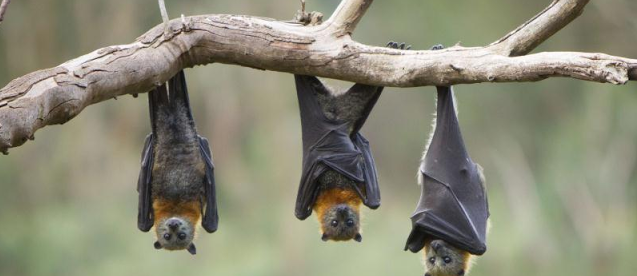Why Do Bats Sleep Upside Down?


In general, it’s easier to do everything right side up. That’s why it’s called “right side up,” after all. But every once in a while, nature does something differently. Bats — the winged, flying mammals which tend to dwell in caves and are anecdotally associated with vampires and other scary stuff — they sleep upside down. It’s likely comfortable for them, sure, but it’s still unusual. Why do bats sleep upside down?
Because while bats can fly, they can’t take off.
Bats aren’t just cursed with poor vision — they’re funky all around, and particularly so when it comes to flying. While some birds can take to the sky from a dead stop by simply flapping their wings, most species of bats can’t. Birds’ wings are long, feathered protrusions which can generate enough thrust to achieve liftoff. Bats’ wings, as ScienceFriday explains, are basically large, webbed hands; the wings are comprised of a skin-like membrane stretched across three jointed bones similar to fingers. Once airborne, a bat can use these wings to maintain the flight over long distances and maneuver seamlessly (and, in many cases, better than birds can). So yes, bats fly — they don’t glide. But they can’t just flap their wings to take off.
So they have to find another way. The good news is that flapping your wings isn’t the only way to get airborne. You can achieve liftoff with a running start, or, in the case of us humans, with a few jet engines pushing a plane forward. Unfortunately, if you’re a bat, you can’t do this either. Most bats have really tiny legs; they’re so underdeveloped that most species of bat can’t even walk. (Vampire bats are an exception: they can walk, but it’s awkward. Here’s a video.) Generating the speed needed to take to the skies is simply impossible.
So instead, bats don’t take off — they fall down.
During the night (because that’s when they’re awake; bats do everything backward), they’ll use their claws to climb up a tree trunk. Once they get high enough off the ground, they drop, using gravity as their initial propulsion system. They don’t have to fall far distances, either — a drop of only a few feet is plenty for a bat to take to the skies. It’s probably not an ideal system, but it’s good enough. (Besides, who are we to judge? They can fly; we can’t.)
But it has a big downside. During the day, bats are asleep and therefore, easy prey for a would-be predator. If bats were to sleep on the ground, they’d be sitting ducks — even if they were startled awake by an attack, they couldn’t get away quickly enough. So, they find a high spot before catching some Z’s. And that’s where those awkward mammal legs come back into play. While bird legs are designed to grip branches and the like in a normal, right-side-up way, bat legs aren’t. They are, however, built for being upside down. As Nat Geo explains, “specialized tendons in bat feet enable them to hang while being perfectly relaxed.”
So what’s going to happen if a predator comes after a sleeping bat? Assuming the bat wakes up in time, the bat will reflexively let go of whatever it is hanging from. In doing so, it will fall toward the ground. And then, instinctively, the bat will take flight. In short, sleeping upside down allows bats to fly away from danger — and they barely have to wake up.
Bonus fact: If you’re a bat, there’s definitely at least one downside — pun not intended — from sleeping upside down: you can’t pee. (Okay, maybe you can pee, but the pee has nowhere to go but down, and most of your body is in the way.) So what does a bat do if it needs to go in the middle of a good day’s sleep? As Mental Floss explains, it takes flight, as bats “just ‘hold it’ until they are flying.”
From the Archives: The Bat Bomb: When the U.S. military considered weaponizing bats.
